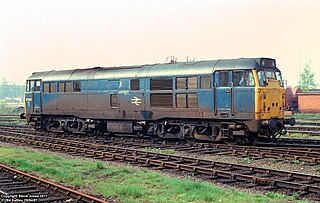Related Research Articles

The British Rail Class 31 diesel locomotives, also known as the Brush Type 2 and previously as Class 30, were built by Brush Traction from 1957 to 1962. They were numbered in two series, D5500-D5699 and D5800-D5862. Construction of the first locomotive was completed in the final week of September 1957, and the handing-over took place on 31 October. The first Class 31 entered service in November 1957, after the launch of the Class 20 locomotive and was one of the Pilot Scheme locomotives ordered by British Railways to replace steam traction.
A number of different numbering and classification schemes were used for locomotives and multiple units operated by British Railways (BR), and this page explains the principal systems. This section also covers the post-privatisation period, as the broad numbering and classification arrangements have not altered since the break-up of BR.

Class 252 was the classification allocated to the prototype High Speed Train (HST) unit, numbered 252001.
A number of different numbering and classification schemes have been used for carriages and wagons on Britain's railways, and this page explains the principal systems. Carriages and wagons have frequently had similar arrangements for classification and numbering, so are considered together. There are also links to other pages that deal in greater depth with the particulars of individual types.
Before the TOPS Class 97 was issued to self-propelled locomotives in departmental use, British Rail had such locomotives numbered in a variety of series, together with locomotives that were no longer self-propelled. See Also:
A wide variety of diesel and electric multiple units have been used on Ireland's railways. This page lists all those that have been used. Except with the NIR Class 3000, the numbers given by each class in the lists below are those allocated to the coaches that make up the units in that class, otherwise, unit numbers are not used in Ireland.

The British Rail Class 37 is a diesel-electric locomotive. Also known as the English Electric Type 3, the class was ordered as part of the British Rail modernisation plan. They were numbered in two series, D6600–D6608 and D6700–D6999.
The London, Midland and Scottish Railway (LMS) pioneered the use of diesel shunting locomotives in Great Britain. The variety of experimental and production diesel shunters produced by the LMS is summarised below.

Cambridge railway station is the principal station serving the city of Cambridge in the east of England. It stands at the end of Station Road, 1 mile (1.6 km) south-east of the city centre. It is the northern terminus of the West Anglia Main Line, 55 miles 52 chains (89.6 km) down the line from London Liverpool Street, the southern terminus.

A motive power depot (MPD) or locomotive depot, or traction maintenance depot (TMD), is where locomotives are usually housed, repaired and maintained. They were originally known as "running sheds", "engine sheds" or just "sheds". Facilities are provided for refuelling and the replenishing of water, lubricating oil and grease and, for steam engines, the disposal of ash. There are often workshops for day-to-day repairs and maintenance, but locomotive building and major overhauls are usually carried out at locomotive works.
A number of different numbering and classification schemes were used for the locomotives owned by the London and North Eastern Railway (LNER) and its constituent companies. This page explains the principal systems that were used. The following abbreviations for the constituent companies are used on this page:

Laira Traction and Rolling Stock Maintenance Depot is a railway traction maintenance depot situated in Plymouth, Devon, England. The depot is operated by Great Western Railway (GWR) and is where their fleet of High Speed Trains are overhauled along with those belonging to CrossCountry. These will be withdrawn in 2023 but it will then become the principal depot for GWR's Class 802 InterCity Express Trains. Other trains visit for daily servicing.

Neville Hill is a railway train maintenance depot in Osmondthorpe, Leeds, England on the Leeds to Selby Line. The depot is situated 2 miles 14 chains (3.5 km) to the east of Leeds railway station on the north side of the line.

Stratford Works was the locomotive-building works of the Great Eastern Railway situated at Stratford, London, England. The original site of the works was located in the 'V' between the Great Eastern Main Line and the Stratford to Lea Bridge route and in the early years was also the home of Stratford Locomotive Depot. The final part of the works closed in 1991.

Stratford TMD was a traction maintenance depot located in Stratford, London, England, close to the Great Eastern Main Line. It was located just west of Stratford station, on a site now occupied by Stratford International station. The depot was, at one time, the biggest on the London and North Eastern Railway with locomotives covering duties from express services to freight workings in London's docks.
The UIC identification marking for tractive stock is a standard for identifying train stock like locomotives that supply tractive force primarily in Europe. Since the beginning of 2007 locomotives or other traction units in Europe have been given a 12-digit number. Vehicle numbering is now governed by the Intergovernmental Organisation for International Carriage by Rail and in Technical Specifications for Interoperability (TSI) of the European Union, specifically the European Railway Agency's CR OPE TSI. This makes the locomotive clearly identifiable within Europe and parts of Asia and northern Africa.
There were a number of engine sheds and railway works located in York. The large York North engine shed became the National Railway Museum in 1975.

Ipswich engine shed was an engine shed located in Ipswich, Suffolk on the Great Eastern Main Line. It was located just south of Stoke tunnel and the current Ipswich railway station. Locomotives accessed the site from Halifax Junction which was also the junction for the Griffin Wharf branch of Ipswich docks. The depot opened in 1846 and closed in 1968 although the site remained in railway use for a further thirty years.
References
- ↑ Smith, Paul; Smith, Shirley (2014). British Rail departmental locomotives 1948-1968 : includes depots and stabling points. Hersham: Ian Allan Publishing. p. 96. ISBN 978-0-7110-3800-4. OCLC 897871236.
- ↑ Boddy et al. (1988), p. 19.
- ↑ Boddy et al. (1988), pp. 14–16, 20–21, 24–27.
- ↑ Boddy et al. (1988), pp. 16–17, 20–21, 24–27.
- ↑ Boddy et al. (1988), pp. 17–18, 22, 24–27.